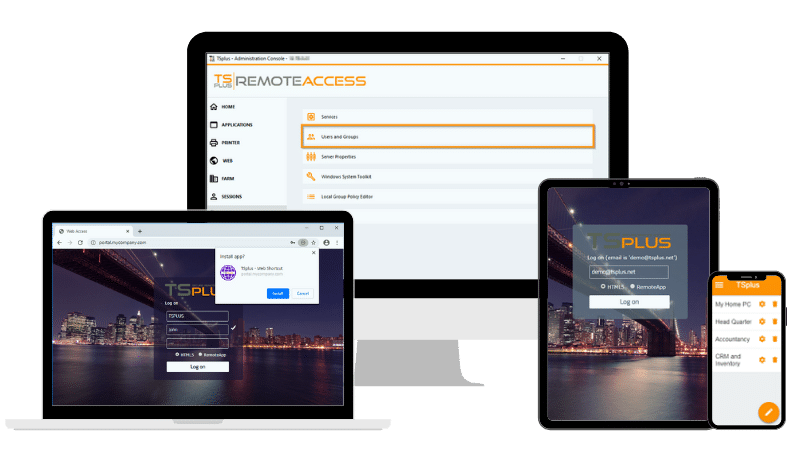)
)

TSplus Remote Access Free Trial
Ultimate Citrix/RDS alternative for desktop/app access. Secure, cost-effective, on-premises/cloud
Technical Foundations of RDP and VNC
Remote Desktop Protocol (RDP)
RDP, a proprietary protocol by Microsoft, operates on a sophisticated client-server architecture. It is engineered to work over TCP/IP. It utilizes standard port 3389, and encapsulates data transmission in a series of encrypted packets. RDP is built on the foundation of the T.120 family of protocols. Building RDP like this makes it highly efficient in remote desktop visualization and management. RDP employs techniques such as bitmap caching, persistent bitmap caching. RDP also framebuffer updates to minimize bandwidth usage and enhance the responsiveness of remote interactions. RDP's capability to redirect certain types of hardware resources like printers, clipboards. It also drives from the client to the server enhances its utility, providing a near-native user experience.
Virtual Network Computing (VNC)
VNC operates on the Remote Framebuffer (RFB) protocol, which is inherently simple yet powerful, allowing it to be platform-independent. The core of VNC's operation lies in transmitting the graphical screen updates from the server to the client in a pixel format. This transmission is done through a variety of encoding schemes such as Raw, Hextile, Tight, and ZRLE, each optimized for different network and performance scenarios. VNC's unique approach allows it to be used across different operating systems without modification, offering a versatile solution for remote access. Additionally, VNC supports simultaneous connections, enabling both shared viewing and collaborative interactions within the same session.
Functionalities and Performances: A Deeper Technical Dive
RDP
Optimizing Experience Over Various Network Conditions
RDP, developed by Microsoft, stands out for its ability to provide a high-quality remote desktop experience, even over low-bandwidth connections. This capability stems from its dynamic adaptation to current network conditions, ensuring that users experience minimal disruption in their workflow:
- Efficient Multimedia Redirection (EMR): This feature optimizes video playback by redirecting multimedia processing from the host to the client side, significantly reducing bandwidth usage and improving playback quality.
- Virtual Channel Extensions: These extensions play a critical role in enhancing the user experience by redirecting device and application states seamlessly. This ensures that peripherals such as printers and scanners work flawlessly in the remote environment.
Network Level Authentication (NLA)
Before establishing a session, RDP employs NLA, a security measure that necessitates authentication of the client by the server. This process mitigates the risk of unauthorized access and potential denial-of-service attacks, thus enhancing the security of the remote session.
VNC
Dependence on Network and Graphical Complexity
VNC (Virtual Network Computing) technology, while robust, has its performance pegged to the network's bandwidth and the graphical complexity of the remote desktop. It transmits pixel data from the server to the client, which, without adjustment for network quality, can result in latency or a reduction in visual clarity in constrained network environments:
- Lack of Adaptive Image Quality: Unlike RDP, VNC does not automatically adjust the quality of the remote desktop image based on the network conditions, which can affect the user experience under less-than-ideal network situations.
Adaptability Through Extensions
The simplicity and universal approach of VNC's pixel-based transmission method make it highly adaptable across various platforms. Despite its reliance on stable network conditions for optimal performance, the VNC ecosystem benefits from numerous third-party optimizations and extensions. These enhancements aim to improve both performance and security, making VNC a versatile choice for many users:
- Third-Party Optimizations: Various third-party solutions are available that can enhance VNC's performance and security. These optimizations can include compression algorithms to reduce bandwidth usage and encryption methods to secure the remote session against eavesdropping and unauthorized access.
In summary, while both RDP and VNC offer unique advantages in remote desktop access, their performance and functionality are influenced by their underlying technologies. RDP's design focuses on optimizing the remote experience across fluctuating network conditions with added security features. VNC's strength lies in its simplicity and adaptability, with performance that can be augmented through third-party solutions. Now that we know the differences between RDP and VNC, an in-depth guide on RDP vs VNC needs to continue with the use cases of these two options.
Application Use Cases
RDP: Optimized for Windows Ecosystems
Deep Integration with Windows
Remote Desktop Protocol (RDP) is uniquely designed to offer seamless and efficient remote access within Windows environments. It leverages advanced Windows features like RemoteFX for superior graphics rendering and Network Level Authentication (NLA) for enhanced security. RDP excels in providing a rich user experience, closely mirroring that of a local desktop, with support for high-definition video and sound.
Wide Client Support
Despite its deep roots in Windows, RDP maintains a broad compatibility range with client platforms. It includes native support on Windows and offers comprehensive solutions for Linux, macOS, iOS, and Android. It does this through both official Microsoft clients and reputable third-party applications. This extensive support ensures that RDP remains a top choice for businesses and IT professionals managing Windows-based servers and desktops, seeking a consistent and high-performance remote access solution .
Ideal Use Cases
RDP is particularly beneficial for enterprise environments with a strong reliance on Windows servers and applications. It's the go-to protocol for tasks requiring high levels of administrative access and control. It does that including server maintenance, application management, and delivering virtual desktops to end-users in a secure and controlled manner.
VNC: Universal Remote Access Solution
Cross-Platform Flexibility
Virtual Network Computing (VNC) stands out for its universal applicability across different operating systems. Unlike RDP, VNC operates at the framebuffer level, making it inherently platform-agnostic. This capability allows VNC to provide remote access to virtually any system with a graphical interface. This includes not just mainstream operating systems like Windows, macOS, and Linux but also various Unix derivatives and embedded systems.
Versatile Application Scenarios
VNC's adaptability is mirrored in its wide range of use cases. It is an excellent tool for delivering remote technical support , facilitating remote education through shared sessions. It enables also collaborative projects by allowing multiple users to view and interact with a single desktop environment simultaneously. This versatility makes VNC an indispensable tool for organizations and IT support teams working in mixed-OS environments. It is also an indispensable tool for requiring flexible remote access solutions that cater to diverse user needs.
Security and Performance Considerations
While VNC provides remarkable flexibility, it's crucial to address security and performance optimizations for optimal use. Implementing encryption mechanisms like Secure Sockets Layer (SSL) or Virtual Private Networks (VPNs) can enhance VNC's security posture. Moreover, selecting the right VNC server and client software that offers performance optimizations for your specific network conditions and use cases can significantly improve the user experience.
RDP vs VNC - Conclusion
Choosing between RDP and VNC involves a nuanced understanding of each protocol's technical specifications, performance characteristics, supported platforms, and security measures. RDP offers a high-performance, Windows-centric solution with extensive administrative capabilities, making it suitable for enterprise environments. Conversely, VNC's simplicity and platform independence render it versatile for a wide range of scenarios, including education, technical support, and collaborative work. By assessing your specific needs against the capabilities and limitations of RDP and VNC, you can identify the most appropriate technology to integrate into your remote access strategy. Doing this will ensure operational efficiency and security in your digital workspace.
To test our remote access solutions, please download a free trial .

TSplus Remote Access Free Trial
Ultimate Citrix/RDS alternative for desktop/app access. Secure, cost-effective, on-premises/cloud














)
)
)